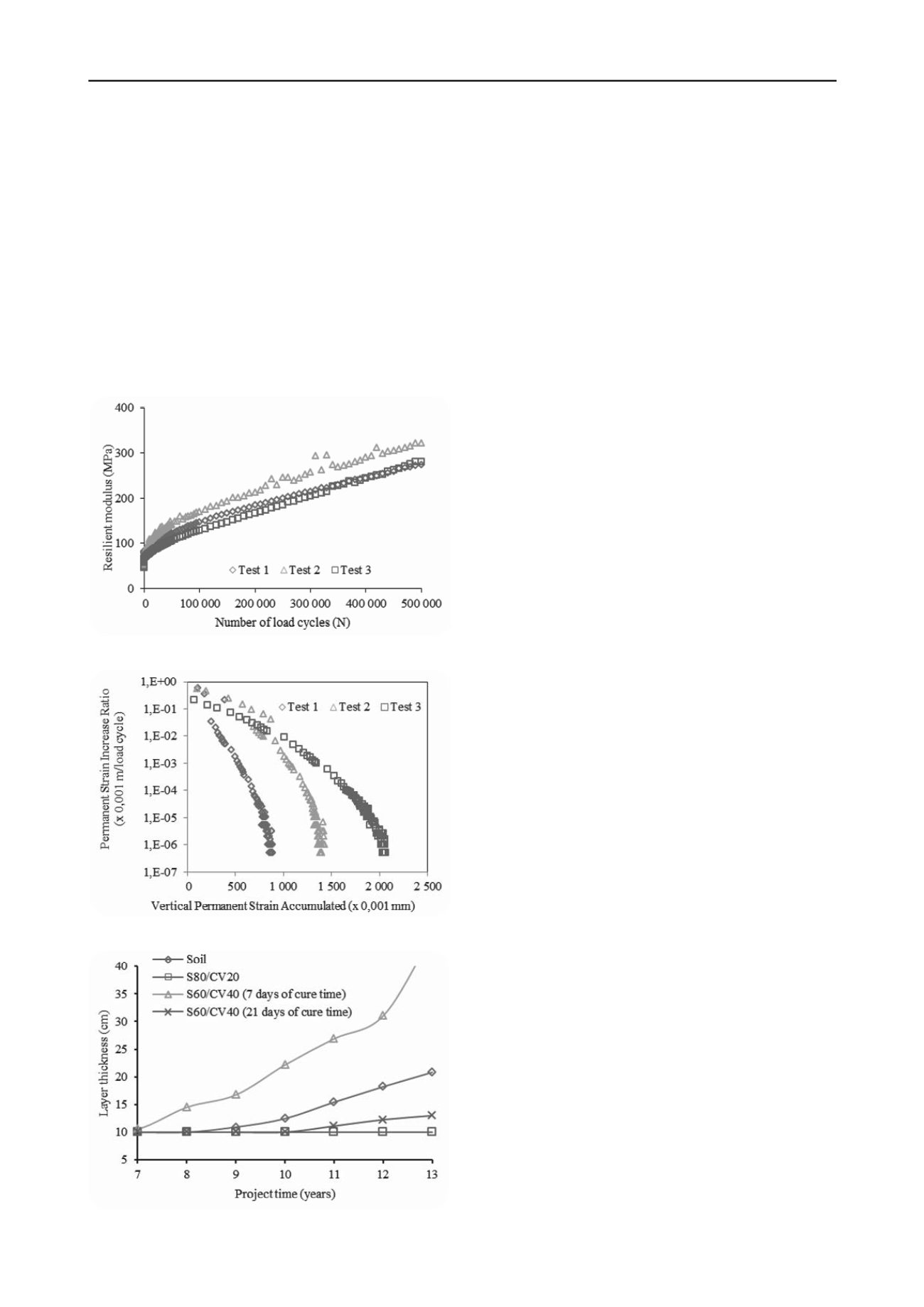
3266
Proceedings of the 18
th
International Conference on Soil Mechanics and Geotechnical Engineering, Paris 2013
4.5 Effect of MSW fly ash addition on expansibility
5 CONCLUSIONS
The MSW fly ash decreases the expansion of the soil in study,
which had an expansion of 4%, but with the addition of fly ash
reduced it to 3.6% for 20% fly ash content and fell to 0.4% to a
level of 40% fly ash. However, high content of fly ash when can
deteriorate the mechanical behavior, resulting in a thicker layer.
4.6 Effect of MSW fly ash addition in pavement base
The mixture with 20% fly ash improved the mechanical
behavior of pure soil, which is revealed by the decrease in
thickness of the base compared to pure soil, for the same
loading level and same parameters (criteria) for sizing. It is
shown in Figure 8 the thickness of layers depending on the
project period for each type of mixture, which was obtained by
the computer program SisPav (Franco, 2007).
Mixtures with the inclusion of MSW fly ash had a mechanical
behavior compatible with the requirements for a low traffic
volume. The addition of 20% fly ash to the non-lateritic clay
soil improved the mechanical behavior and reduced the
expansion of the soil. The soil mixed with a content of 40% of
fly ash decrease the mechanical behavior compared to pure soil,
with the consequent increase in thickness; however, it improved
with cure time and cycle loading number, decreasing
significantly the expansion of the soil.
The results were satisfactory, being dependent on the ash
content added, cure time and cycle loading number, highlighting
the positive work of MSW fly ash for use in base layers of road
pavements, eliminating the current problems of waste disposal
in dumps and landfills.
6 ACKNOWLEDGEMENTS
The authors thank CNPq (MCT/CNPq 14/2009 # 480748/2009-
8 project) for the financial support, as well as Usina Verde S.A.
for the Municipal Solid Waste ash supply.
7 REFERENCES
AASHTO. 1996. TP46-94 - Standard Test Method for Determining the
Resilient Modulus of Soils and Aggregate Materials. American
Association of State Highway and Transportation Officials,
Washington, D.C.
Bernucci, L. L. B. 1995. Considerations about pavement design using
lateritic soils on low traffic volume roads. PhD Thesis. Polytechnic
school of University of São Paulo, São Paulo, SP, Brazil (In
Portuguese).
Figure 6. Resilient Modulus Variation.
Brazilian Technical Standards Association ABNT. NBR 10005/04:
Procedure for obtention leaching extract of solid wastes
.
Brazilian Technical Standards Association ABNT. NBR 10006/04:
Procedure for obtention of solubilized extraction of solid wastes.
Fontes, C. M. A. 2008. Utilization of the sewage sludge and urban solid
waste ashes in high performance concrete. PhD Thesis. Federal
University of Rio de Janeiro, Brazil (In Portuguese).
Franco, F. A. C. P. 2007. Mechanistical-empirical asphalt pavement
design method - SisPAV. PhD Thesis. Federal University of Rio de
Janeiro, Brazil (In Portuguese).
Guimaraes, A. C. R. 2009. A mechanistical empirical method to predict
permanent deformation on tropical soils on pavements. PhD Thesis.
Federal University of Rio de Janeiro, Brazil (In Portuguese).
Nogami, J. S., Villibor, D. F. 1995
. Pavimentos de Baixo Custo com
Solos Lateríticos
, Editora Villibor, São Paulo. 240 p (In
Portuguese).
Vizcarra, G.O.C. 2010. Aplicability of municipal solid waste for
pavements base. M.Sc. Disssertation. Department of Civil
Engineering, Pontifical Catholic University of Rio de Janeiro,
Brazil (In Portuguese).
Figure 7. Shakedown´s occurrence search.
Werkmeister, S. 2003. Permanent Deformation Behavior of Unbound
Granular Materials in Pavement Construction. These. Technical
University of Dresden.
Figure 8. Layer Thickness according to Project Time


